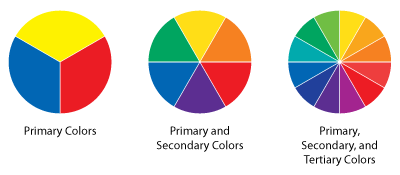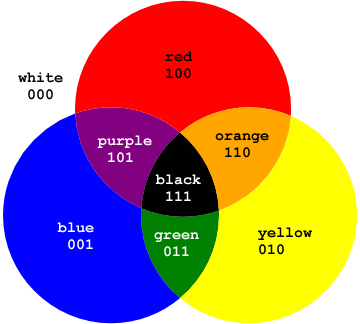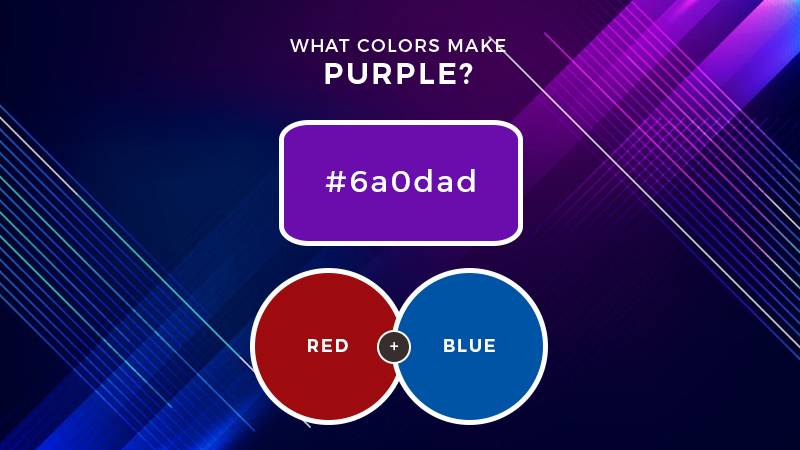What Colors Make Purple? What Two Colors Make Purple
Are you trying to figure out what colors make purple? Are you trying to mix colors and want to know what two colors make purple?
In this article we will go in-depth and explain how to combine colors to create more colors, and some fundamental color principles that can be applied to anything like mixing paint, hair dye, food coloring, etc.
If you follow the basic color theory, you will find that you can mix primary colors to create secondary colors, and then mix the adjacent colors again to create tertiary colors.
Here is a simple color chart that displays these three scenarios.
As you can see from the image above you get the following:
The Primary Colors are: Red, Yellow, and Blue
The Secondary Colors are: Green, Orange, and Purple
The Tertiary Colors are: Yellow-Orange, Red-Orange, Red-Purple, Blue-Purple, Blue-Green, and Yellow-Green
Here is a Color Wheel that displays this.
As you can see, if you have the foundation colors of Red, Yellow, and Blue you can mix them together to build a nice color palette.
But you’re probably thinking, “that still doesn’t explain what colors mix to make purple.”
Ok, let’s get started…
What Two Colors Make Purple
As mentioned above if you mix two primary colors together you can create purple because purple is a secondary color.
Simply put…
When you mix Blue and Red together you get Purple!
But, what if you’re looking for a different shade of purple?
Well, I’m glad you asked…
You can create different shades of purple by mixing different shades of red and blue.
See this diagram below as it explains if you mix Warm Red with Blue you get a nice deep purple. Whereas if you mix a lighter shade of blue and warm red you will get a lighter purple.
The color combinations are endless!
As you can see Magenta, and Warm Red are all part of the same color family, and Cyab Blue is another shade of blue. As long as you’re mixing different shades of blue or red you can still get a version of purple.
What Colors Make Purple Paint
Personally, the biggest disappointment is usually when I discover as a grown-up that something that I grew up believing in as a kid is not true. That is how it is for most of us when it comes to mixing colors.
Assuming that we all had a knack for colors as we grew up, we were all taught that mixing blue and red gives us purple, yellow with blue gives us green, and red with yellow gives us orange.
Trying to put that into practice does not get us the results that we have known all our lives to be true. It either gets us some funny shade of the target color, say purple, or something that is not even close to it.
Then we end up believing that blue and red cannot get you purple.
Well, not exactly.
Red and blue DO make purple. The problem lies in the quantity of the two colors that you have used, and mostly, their shade (hue). Being primary colors, red and blue have many shades and failure to pick the right one will produce some very strange purple-ish colors that you won’t be satisfied with.
Some of the shades of red that exist are; cadmium red light, permanent rose, pyrrole, vermillion, scarlet, alizarin crimson, pyrrole crimson, magenta, and thalo red. Those of blue include; permanent blue, turquoise, ultramarine blue, cobalt, Prussian, Antwerp, manganese, etc.
With such an overwhelmingly large number to choose from, it is common to find people not knowing what to pick to get what color.
Why do some people think red and blue fail to make purple?
Let me explain further…
– We all know that yellow is a complementary color for purple and mixing them together will cause a de-saturation of the purple, turning it dull. It is important to check the primary colors that you are using (blue and red for this case) to ensure that they do not contain yellow.
– Most people who fail at this use a typical or standard palette of colors that cannot result in yellow. The colors that are used in making palettes include cadmium red, cadmium yellow medium, ultramarine blue, curelean blue, cobalt, and alizarin crimson, among others. Mixing red and blue from the color palette outlined above does not give you purple. At least not a clean purple. For example, picking cadmium red which has a color bias of yellow, and mixing it with whatever shade of blue (for example ultramarine blue) that you can think of will not give you a clear purple.
For you to get clean purple from your mixture, you need to have a strong red with a strong color bias of blue and not have any elements of yellow. However, there are cases where a red with a color bias of blue with no traces of yellow, mixed with a shade of blue with a color bias of red, does not give you the clean bright purple that you were aiming for. For example, picking alizarin crimson, and ultramarine blue.
Depending on the shade of purple that you want, you can pick from the different blues and reds, avoiding all the standard palettes of colors, and those that have traces of yellow.
Conclusion
Now you can see that there are many ways to combine colors to make purple. You can start with a basic color palette and mix blue and red together to make purple.
Or you can mix multiple colors together to get different shades of purple. Either way, you have to experiment to find what works best for you. This is a nice skill to have that you can apply to mix paint, markers, or even nail polish.
The applications of mixing colors are endless!
We hope you enjoyed this guide on what colors make purple. Be sure to comment below and share what color combinations have worked best for you. Cheers!
Read Latest Posts

Hi, I'm Anthony Tran! Welcome to my site. I live in Arizona and am obsessed with all things related to building an Online Business and working from home. Learn about my journey here.
Follow Online







